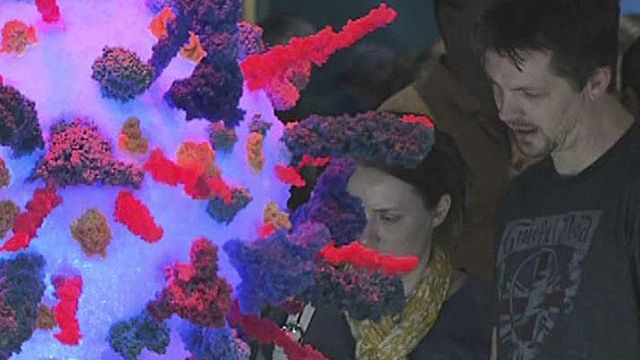The Nature Research Center has something for everyone
It may seem incredible, but the new addition to the North Carolina Museum of Natural Sciences really does live up to the hype.
Posted — UpdatedIt may seem incredible, but the new addition of the North Carolina Museum of Natural Sciences really does live up to all the hype.
The Nature Research Center is finally complete. The Tyrannosaurus Rex bones are all in place, the stingrays are zooming happily through their tank and the cafe is stocked with cupcakes.
People were packed around the exhibits and lined down the street on Friday, the day of the 24-hour grand opening, to see what new things the museum has to offer.
On my walk-through, I tried to focus on the main attractions that would be of interest to the greatest number of people. That being said, there are so many intriguing and interesting exhibits that it really was difficult to pick just a few must-sees.
There's something here for everyone, be it DNA, outer space, engineering, microorganisms or extinct beings.
- When you walk in on the first floor, you may be tempted to gaze in awe at Stumpy, the right whale who was killed while pregnant with her sixth calf. She's definitely worth a look, but past her in the far right corner is the Exploring the Deep Sea Exhibit, which takes you on a virtual deep-sea dive. Only a few people can go in at a time, so there was a long line. I would hop in line when you get there so the wait isn't any longer, and then spend time with Stumpy.
- Also past Stumpy is the Our Changing Ocean Exhibit, a 10,000-gallon tank that replicates a habitat off the N.C. coast. I love stingrays (there were two!), so that might be why I liked this exhibit, but it was still neat. The tank is shaped in a way that there is plenty of viewing space, so even if there is a crowd you should still be able to see.
If you're a hands-on learner, the museum has you covered there, too. Screens throughout the wing feature simulators that let you try your hand at, say, reducing the amount of carbon in the atmosphere. You must try to balance between cost, efficiency, environmental impact and other factors.
WRAL Storm Central allows you to be the forecaster
I was disappointed that the WRAL Storm Central exhibit wasn't open for people to try out Friday, because that's the one I was looking forward to the most. However, I was able to talk to WRAL meteorologist Nate Johnson, who played a large part in developing the exhibit. One of the things that makes Storm Central so great is that real data and radar images are used.
"It allows (visitors) to look at the variables just like we do in order to make a forecast. Plus, since we're using current data, it's almost like a different exhibit every time people visit," Johnson said.
The point of Storm Central is to show people exactly how much science and technology goes into making just one weather forecast. And just in the past few decades, this science has vastly improved.
"Some folks joke about weather forecasting and how it's always wrong," said Johnson. "The exhibit does a good job of showing some of the data we use and explaining the process we use to discern from those data and what the atmosphere is going to do."
Don't be intimidated by the real technology, though. The exhibit is carefully formed to be easily understood (if you don't know what a cold front is, you can still do this!).
And what's the most exciting part of the exhibit?
"Hopefully we'll inspire a budding meteorologist by letting them do a forecast," said Johnson.
Well, there you have it. There's an incredible amount of information just waiting to be explored at the Nature Research Center; you could easily spend hours in there. If you still think it won't live up to the hype, you'll have to go down there and see for yourself.
Related Topics
Copyright 2024 by Capitol Broadcasting Company. All rights reserved. This material may not be published, broadcast, rewritten or redistributed.






